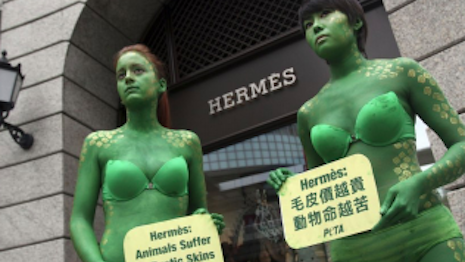- About
- Subscribe Now
- New York,
November 27, 2017

 Hermès becomes involved in crocodile skin scandal. Image credit: Fashionbi
Hermès becomes involved in crocodile skin scandal. Image credit: Fashionbi
Social media is giving consumers much more power over brands, where a mob-like mentality can influence the business practices and decisions of these companies, as well as their reputations.
Whether it is social issues, business practices or customer service issues, the Internet has given consumers the tools to hold brands accountable for their actions. Brands such as Hermès, Balenciaga, Valentino and Nordstrom are only a few of the luxury marketers who have fallen victim to the harsh reaction of social media, exhibiting how brands of today need to be more careful.
“Any brand can be criticised and attacked by the public if the audience will notice a discrimination or unfair, even if there were no wicked intention from the company's side,” said Yana Bushmeleva, chief operating officer at Fashionbi, Milan. “A single post on social media channel can bring visibility to the issue on the international level.
“And as the result, the society can have a direct influence on the decisions of the fashion; for example, to remove the product from the market or to do an official and public apologize. Taking into consideration that the fashion industry is becoming more democratic and inclusive the brands should be even more attentive to the product designs and communication campaigns.”
Faux pas in fashion
In Fashoinbi’s new "Fashion Brands and the Reputation Risks" report, the backlash many brands have received on social media details the risks involved.
Many brands have fallen victim to the Internet machine and negative viral commotion regarding various aspects of their businesses. But it is how these brands handle these incidences that can make or break them.
For instance, Prada recently received negative attention when a very prominent vlogger released a video on YouTube to her six million followers detailing a story about the label’s bad customer service. The video quickly received upwards of 800,000 views and caused many social media users to bash the brand.
Prada worked quickly to fix the situation by issuing a full refund to the blogger or returning her bag. This prompted the YouTube star to release another video explaining how great the brand was in correcting the situation.
However, social media backlash can run deeper than a simple customer service issue. Hermès saw significant outrage after a video from the People for the Ethical Treatment of Animals released a video of cruel practices had been used against crocodiles in the making of its Birkin Croco bag.
Burberry faces protests in regards to fox fur. Image credit: Fashionbi
The video prompted the bag’s namesake, Jane Birkin to release a statement demanding her name be removed from the label. However, Hermès explained that it contacted the farm and demanded it changes its practices or it would cease its relations, which satisfied Ms. Birkin.
Many fashion brands have also been caught up in significant misunderstandings, especially involving race. Both Moncler and Dolce & Gabbana have seen issues in regards to product design that the public deemed racist.
For instance, Dolce & Gabbana’s spring/summer 2013 collection designs of “Moorish” figures, known as the conquers of Sicily and a staple in art culture, was wrongly mistaken for depicting images of slaves. Moncler’s 2016 line featured a face of friendly penguin named Malfi but was mistaken as the 19th-century racist doll, a golliwog.
Both brands attempted to clear up the misunderstanding by issues statements explaining the products.
Valentino's ad called racist by having black women used as a background. Image credit: Valentino.
French fashion label Jean Paul Gaultier promoted its latest fragrance, Scandal, with a voyeuristic paparazzi-themed campaign on social media.
The posts for the brand’s new fragrance include short videos filmed in a lo-fi way mimicking the look of a hastily shot cellphone camera video. The campaign's concept is to ape the style of edgy, unsanctioned videos shot in private to emphasize the more dangerous aspects of the brand (see more).
Big fashion houses are also accustomed to knock-offs and cheap counterfeits floating around, but when the tables are turned and designer labels are the ones accused of plagiarism, the issue becomes more complicated.
This was demonstrated in two recent high-profile instances of a big-name fashion brand being publicly accused of stealing designs from smaller and less-notable designers. First, Gucci was accused of stealing a design from New York designer Dapper Dan, and Balenciaga followed soon after with allegations that it had stolen designs from a Ruff Ryders shirt (see more).
Best practices
Brands need to be on the constant look out for any allegations similar to this so they can be dealt with and nipped in the bud before it gets out of hand. Admitting wrongdoing can be a significant help after a scandal.
When it comes to product scandals, fast fashion and luxury brands need to take separate precautions. Mass merchants are able to pull products off the shelves with much less costs, but for luxury brands this is much more costly, making an apology the best strategy.
Cutting off relationships with third party wrongdoers is vital to save face with the public when something has happened with a brand that is out of their control.
“It was quite a surprise to discover how operative and sincere some brands were in the reaction to such scandals, e.g. Dove’s racially insensitive body wash advertisement,” Fashionbi's Ms. Bushmeleva said.
Share your thoughts. Click here